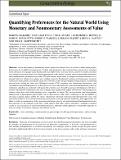Quantifying preferences for the natural world using monetary and nonmonetary assessments of value
Abstract
Given that funds for biodiversity conservation are limited, there is a need to understand people's preferences for its different components. To date, such preferences have largely been measured in monetary terms. However, how people value biodiversity may differ from economic theory, and there is little consensus over whether monetary metrics are always appropriate or the degree to which other methods offer alternative and complementary perspectives on value. We used a choice experiment to compare monetary amounts recreational visitors to urban green spaces were willing to pay for biodiversity enhancement (increases in species richness for birds, plants, and aquatic macroinvertebrates) with self-reported psychological gains in well-being derived from visiting the same sites. Willingness-to-pay (WTP) estimates were significant and positive, and respondents reported high gains in well-being across 3 axes derived from environmental psychology theories (reflection, attachment, continuity with past). The 2 metrics were broadly congruent. Participants with above-median self-reported well-being scores were willing to pay significantly higher amounts for enhancing species richness than those with below-median scores, regardless of taxon. The socio-economic and demographic background of participants played little role in determining either their well-being or the probability of choosing a paying option within the choice experiment. Site-level environmental characteristics were only somewhat related to WTP, but showed strong associations with self-reported well-being. Both approaches are likely to reflect a combination of the environmental properties of a site and unobserved individual preference heterogeneity for the natural world. Our results suggest that either metric will deliver mutually consistent results in an assessment of environmental preferences, although which approach is preferable depends on why one wishes to measure values for the natural world.
Citation
Dallimer , M , Tinch , D , Hanley , N , Irvine , K N , Rouquette , J R , Warren , P H , Maltby , L , Gaston , K J & Armsworth , P R 2014 , ' Quantifying preferences for the natural world using monetary and nonmonetary assessments of value ' , Conservation Biology , vol. 28 , no. 2 , pp. 404-413 . https://doi.org/10.1111/cobi.12215
Publication
Conservation Biology
Status
Peer reviewed
ISSN
0888-8892Type
Journal article
Description
This work was supported by EU-FP7 Marie Curie Fellowship. Grant Number: 273547Collections
Items in the St Andrews Research Repository are protected by copyright, with all rights reserved, unless otherwise indicated.

